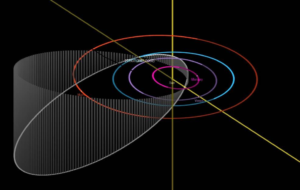In News: On March 21, 2001 FO32 will pass by at about 124,000 kph – faster than the speed at which most asteroids encounter Earth.
About 2001 FO32 asteroid
- The largest asteroid Called 2001 FO32, the near-Earth asteroid will make its closest approach at a distance of about 1.25 million miles (2 million kilometers) – or 5 1/4 times the distance from Earth to the Moon.
- There is no threat of a collision with our planet now or for centuries to come.
- During this approach, 2001 FO32 will pass by at about 77,000 mph (124,000 kph) – faster than the speed at which most asteroids encounter Earth.
- The reason for the asteroid’s unusually speedy close approach is its highly inclined and elongated (or eccentric) orbit around the Sun, an orbit that is tilted 39 degrees to Earth’s orbital plane.
- This orbit takes the asteroid closer to the Sun than Mercury and twice as far from the Sun as Mars.
- As 2001 FO32 makes its inner solar system journey, the asteroid picks up speed like a skateboarder rolling down a halfpipe, and then slows after being flung back out into deep space and swinging back toward the Sun.
- It completes one orbit every 810 days (about 2 1/4 years).
Astronomical Geology
- Asteroid 2001 FO32 was discovered in March 2001 by the Lincoln Near-Earth Asteroid Research (LINEAR) program in Socorro, New Mexico.
- Estimated, based on optical measurements, to be roughly 3,000 feet (1 kilometer) wide. I
- Recent follow-up observations by NEOWISE, 2001 FO32 appears to be faint when observed in infrared wavelengths, which suggests the object is likely less than 1 kilometer in diameter.
- Analysis by the NEOWISE team shows that it is between 1,300 to 2,230 feet (440 to 680 meters) wide.
- The last notably large asteroid close approach was that of 1998 OR2 on April 29, 2020. While 2001 FO32 is somewhat smaller than 1998 OR2, it will be three times nearer to Earth.

What is Asteroids ?
- Asteroids orbit the Sun and are small bodies in the solar system.
- The asteroid belt in the Solar System, located roughly between the orbits of the planets Jupiter and Mars.
- Made up of metals and rocks.
- Have shorter and elliptical orbits.
- Do not produce a coma or tail atmosphere.
Classification of Asteroids
- Main Asteroid Belt
- Trojans
- Near-Earth Asteroids
















